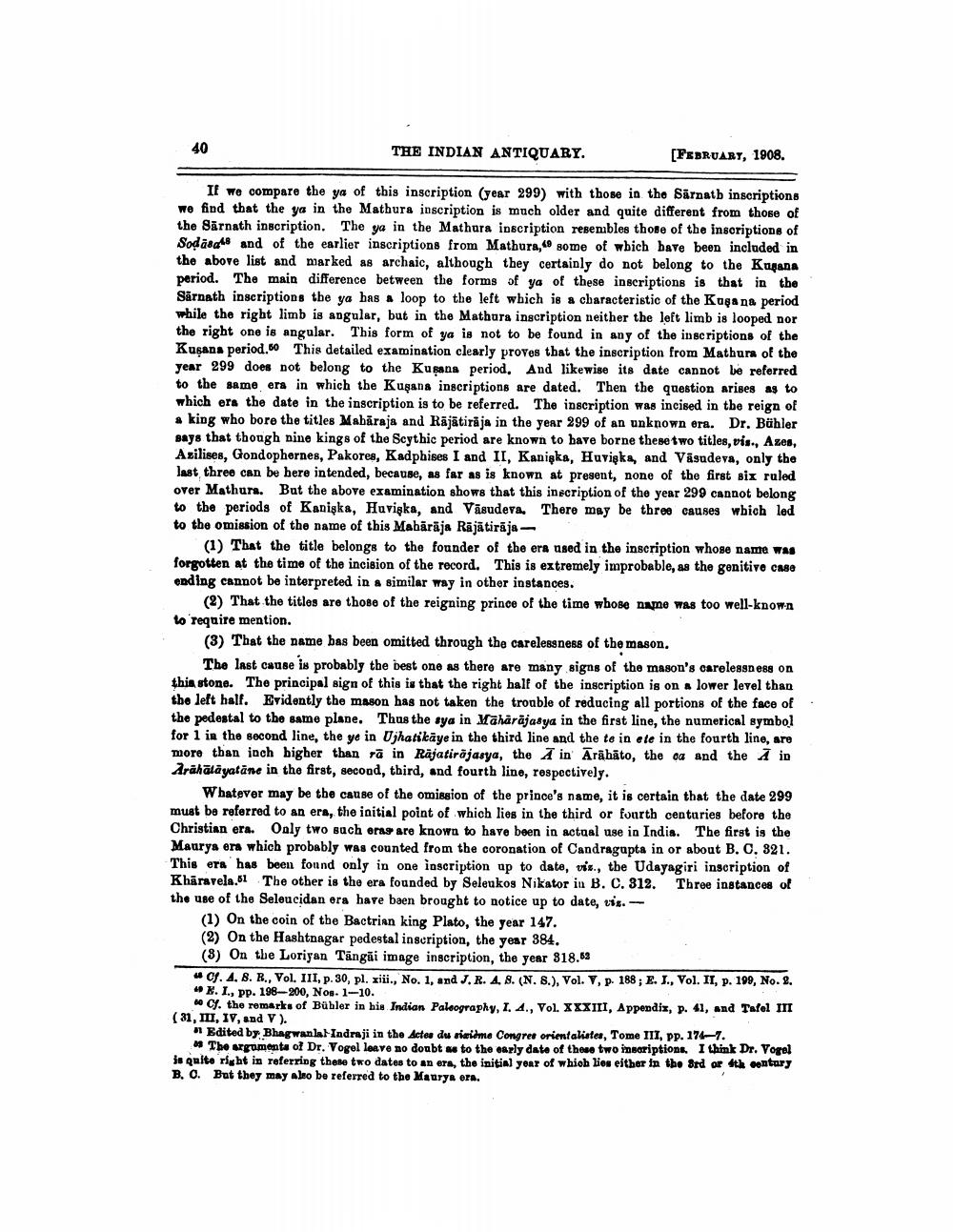________________
40
THE INDIAN ANTIQUARY.
[FEBRUARY, 1908.
If we compare the ya of this inscription (year 299) with those in the Sārnatb inscriptions we find that the ya in the Mathura inscription is much older and quite different from those of the Sārnath inscription. The ya in the Mathura inscription resembles those of the inscriptions of Soda8a48 and of the earlier inscriptions from Mathura, to some of wbich bave been included in the above list and marked as archaic, although they certainly do not belong to the Kngana period. The main difference between the forms of ya of these inscriptions is that in the Sarnath inscriptions tbe ya has a loop to the left which is a characteristic of the Kuşa na period while the right limb is angular, but in the Mathura inscription neither the left limb is looped nor the right one is angular. This form of ya is not to be found in any of the inscriptions of the Kuşans period. This detailed examination clearly proves that the inscription from Mathura of the year 299 does not belong to the Kuşana period. And likewise its date cannot be referred to the same era in which the Kuşans inscriptions are dated. Then the question arises as to which ers the date in the inscription is to be referred. The inscription was incised in the reign of a king who bore the titles Mabāraja and Rajātiraja in the year 299 of an unknown era. Dr. Bühler says that though nine kings of the Scythic period are known to have borne these two titles, vis., Azes, Azilises, Gondophernes, Pakores, Kadphises I and II, Kanişka, Huvişke, and Väsudeva, only the last three can be here intended, because, as far as is known at present, none of the first six ruled over Mathura. But the above examination shows that this inscription of the year 299 cannot belong to the periods of Kaniska, Huvieka, and Vasudeva. There may be three causes which led to the omission of the name of this Mabärāja Rājātirāja -
(1) That the title belongs to the founder of the era used in the inscription whose name was forgotten at the time of the incision of the record. This is extremely improbable, as the genitive case ending cannot be interpreted in a similar way in other instances.
(2) That the titles are those of the reigning prince of the time whose name was too well-known to require mention.
(3) That the name bas been omitted through the carelessness of the mason.
The last cause is probably the best one as there are many signs of the mason's carelessness on this stone. The principal sign of this is that the right half of the inscription is on a lower level than the left half. Evidently the mason has not taken the trouble of reducing all portions of the face of the pedestal to the same plane. Thus the sya in Maharajasya in the first line, the numerical symbol for 1 in the second line, the ye in Ujhatikāye in the third line and the te in ete in the fourth line, are more than inch higher than rã in Rajatirājasya, the A in Arāhāto, the oa and the , in Arahālayatāne in the first, second, third, and fourth line, rospectively.
Whatever may be the cause of the omission of the prince's name, it is certain that the date 299 must be referred to an era, the initial point of which lies in the third or fourth centuries before the Christian era. Only two each oras are known to have been in actual use in India. The first is the Maurya era which probably was counted from the coronation of Candragupta in or about B. C. 321. This era has been found only in one inscription up to date, vie., the Udayagiri inscription of Khāravela.1 The other is the era founded by Seleukos Nikator in B. C. 312. Three instances of the use of the Seleucidan era have baen brought to notice up to date, tis. -
(1) On the coin of the Bactrian king Plato, the year 147. (2) On the Hashtnagar pedestal inscription, the year 884. (8) On the Loriyan Tängãi image inscription, the year 818.62
C. 4.8. R., Vol. III, p. 30, pl. xiii., No. 1, and J.R. 4. 8. (N. 8.), Vol. V, p. 188; E. J., Vol. 11, p. 199, No. 2. # . I., PP. 198-200, Nos. 1-10.
Cf. the remarks of Bühler in his Indian Paleography, I. 4., Vol. XXXIII, Appendix, p. 41, and Tafel III ( 21, III, IV, and V).
Edited by Bhagwanlal-Indraji in the Actes du nici me Congres orientalistes, Tome III, pp. 171-1.
The argumenta of Dr. Vogel leave no doubt as to the early date of these two inscriptions. I think Dr. Vogel is quite right in referring these two dates to an era, the initial Yoar of which lies either in the Brd or 4th century B.O. But they may also be referred to the Maurya era.




